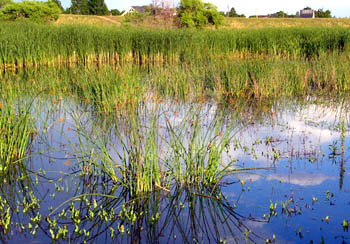
Dr. Pepper Snapple Group (DPS) recently pledged $1.1 million to the Nature Conservancy to help conserve wetlands in Texas. The project will improve water quality and quantity by preserving the “prairies’ sponge-like attributes”—including the Clymer Meadow Preserve in Hunt County where DPS draws water for its bottling plants.
Indeed, wetlands prevent flooding by holding water much like a sponge. By doing so, wetlands help moderate river levels and filter the surface water. This process also creates positive effects for the fauna by providing habitat for fish and birds, making wetlands an important ecological zone.
According to Laura Huffman, Texas state director of the Nature Conservancy, “These projects cover nearly 7,500 acres of land near major metropolitan areas populated by a combined 15 million residents, and DPS’s involvement will help ensure these fast-growing areas, including their operations, will continue to have access to clean, reliable water.”
No doubt folks at Dr. Pepper care about flora and fauna and are smart to market themselves as green by protecting watersheds. But for DPS and other beverage companies, the impetus is their bottom line. Conserving water guarantees long-term access to the main ingredient in their products—clean water. “As a beverage company, water is in everything we do; it’s a primary ingredient,” said Tim Gratto, Dr. Pepper’s vice president of sustainability.
Coca-Cola Co. has also committed to improving water efficiency. “We know the importance of water to the world and the planet, and we know the importance of water to our business,” said Bea Perez, the company’s chief sustainability officer. The company’s long-term plans define water “as a lifeblood… but also as a risk.”
As reported by the AP:
For Pepsi, the wakeup call came when it laid out four possible scenarios for 2030 and discovered water was the greatest risk in each. Last year, Pepsi met its goal of becoming 20 percent more efficient by 2015, saving the company some $17 million in water expenses over five years, said Dan Bena, the company’s director of sustainability.
Pepsi’s other goal is to provide 3 million people with access to clean drinking water by 2015, and it has partnered with environmental groups to focus on rural areas in parts of the developing world. Each day, Bena said, 200 million hours are spent hauling water to communities that have no plumbing — more hours than all employees at Wal-Mart, UPS, McDonald’s, IBM, Target and Kroger work in a week.
If you free up that time, he said, people can work more, making money that could be spent buying Pepsi products. And for beverage companies, that’s the point.
If there wasn’t a thick blanket of snow currently covering my home state of Montana I might try to work on one of the wetland projects featured in PERC Reports, but given the conditions, I will opt to drink Dr. Pepper and sing their catchy ad campaign from the 80s.
Disclaimer: I am addicted to Diet Dr. Pepper so this post may be biased. For more information on ecosystem services, see PERC’s Policy Series “Designing Payments for Ecosystem Services” by James Salzman.


